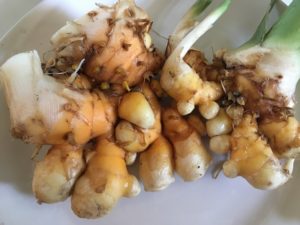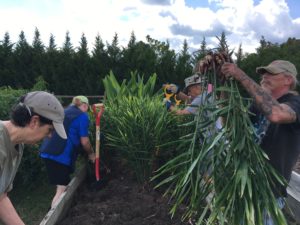Ginger and Turmeric: Tropical Superfoods for the Garden
go.ncsu.edu/readext?556494
en Español / em Português
El inglés es el idioma de control de esta página. En la medida en que haya algún conflicto entre la traducción al inglés y la traducción, el inglés prevalece.
Al hacer clic en el enlace de traducción se activa un servicio de traducción gratuito para convertir la página al español. Al igual que con cualquier traducción por Internet, la conversión no es sensible al contexto y puede que no traduzca el texto en su significado original. NC State Extension no garantiza la exactitud del texto traducido. Por favor, tenga en cuenta que algunas aplicaciones y/o servicios pueden no funcionar como se espera cuando se traducen.
Português
Inglês é o idioma de controle desta página. Na medida que haja algum conflito entre o texto original em Inglês e a tradução, o Inglês prevalece.
Ao clicar no link de tradução, um serviço gratuito de tradução será ativado para converter a página para o Português. Como em qualquer tradução pela internet, a conversão não é sensivel ao contexto e pode não ocorrer a tradução para o significado orginal. O serviço de Extensão da Carolina do Norte (NC State Extension) não garante a exatidão do texto traduzido. Por favor, observe que algumas funções ou serviços podem não funcionar como esperado após a tradução.
English
English is the controlling language of this page. To the extent there is any conflict between the English text and the translation, English controls.
Clicking on the translation link activates a free translation service to convert the page to Spanish. As with any Internet translation, the conversion is not context-sensitive and may not translate the text to its original meaning. NC State Extension does not guarantee the accuracy of the translated text. Please note that some applications and/or services may not function as expected when translated.
Collapse ▲Ginger (Zingiber officinale) and turmeric (Curcuma longa) are native to tropical parts of Asia. They are members of the ginger family, Zingiberaceae, and are grown for their rhizomes, which are edible and known for their flavor and health benefits. Rhizomes are a type of root structure, so the part we eat grows underground. The ginger rhizome has a sharp, warming flavor and is popular in teas, desserts, and many other dishes. The turmeric rhizome has a bright orange-yellow color and is used both in cooking and for dyes.

Turmeric has a bright orange or yellow color. To prevent staining, wear gloves when processing the rhizome.
It has a bitter, earthy flavor. Both are known for their anti-inflammatory, immune-boosting, and even anti-carcinogenic properties.
In tropical climates, ginger and turmeric are perennial plants, meaning that they live for multiple years. For harvest, the plants are dug up, rhizomes divided, and part of the rhizome is kept for use and other parts are reserved for re-planting. They will not survive temperatures below freezing, so in our climate they can only grow during our frost-free period, typically late April through mid-October. They must be harvested before frost in the fall when grown outside. Most ginger and turmeric rhizomes you purchase have a thick skin and are shelf-stable; that is, they can be stored safely on your countertop without going bad. Our growing season is too short for the thick skin to develop on the rhizome, so we can only grow a thin-skinned tender baby ginger or turmeric rhizome. Baby rhizomes must be refrigerated, eaten, or further processed upon harvest. Though not shelf-stable the young rhizomes are more tender than the older, shelf-stable form, and you may find you don’t need to remove the peel before cooking.
To produce a shelf-stable rhizome, we would need to let the plant and rhizome grow for about 4 months beyond our frost-free period. If this is what interests you, consider growing your plants in a pot so that they can be brought inside for the winter. In this method, you can dig and divide the rhizomes for consumption and re-planting as you please.
Both ginger and turmeric can grow in partial shade, only requiring a site with 2-5 hours of sun each day. The plants actually stay greener growing in shade, whereas they can exhibit some yellowing in the leaves from getting too much sun. However, studies being done at NC A & T University in Greensboro show that the rhizomes will grow more when plants are in full-sun compared to shady conditions. Ginger and turmeric do well in sites with loose, well-drained soil that has ample and consistent water. They also do well in soils high in organic matter. An ideal spot would be a raised bed filled with peat or compost-based soil mix and straw mulch covering the rhizomes to maintain moisture.
To plant ginger and turmeric, the rhizomes must undergo sprout initiation, where the aboveground leafy part of the plant starts growing from the rhizome. To initiate sprouts, place a 1.5” piece of rhizome in potting media with ample moisture in a warm, humid location (72-80 degrees F) for 4-6 weeks. A tray with a plastic dome or some kind of enclosed container is ideal to keep in moisture, but light is not necessary until the sprouts start growing. You can sprout either mature, shelf-stable rhizomes, or baby rhizomes may also produce sprouts. Once they have sprouted, gradually harden them off before planting. Take the plants outside an hour or two per day, gradually increasing that time, for approximately two weeks before transplanting outside. It is recommended to use rhizomes intended for planting, but you can also use rhizomes purchased in a grocery store. They may be treated with a sprout retardant, so soak the rhizome for 24 hours before trying to initiate the sprouts. As the sprouting process can take several weeks, aim to get started about 6 weeks before you want to plant outside.
Ginger and turmeric prefer a neutral or slightly acidic pH. Amend the soil with lime as needed and a slow-release balanced fertilizer before planting. The best way to capture any nutrient deficiencies in your soil is to take a soil test. Soil test kits are available at our office (120 Hospital Ave NE Suite #1, Lenoir, NC 28645). Correct any phosphorus or potassium deficiency before planting. Ginger and turmeric also benefit from plenty of calcium and nitrogen in the soil. If lime is recommended by the soil test, this should supply sufficient calcium; if not, consider incorporating a fertilizer with calcium ahead of planting. Nitrogen should be applied several times through the season- once before planting and then every 6-8 weeks through the growing season.
These plants benefit from growing as long as possible, so wait until frost is in the forecast, and dig them up before the frost hits. To harvest, simply loosen the soil around the plant with a shovel or spading fork and lift the plant out of the soil. The rhizomes have lots of nooks and crannies, so they require some patience when cleaning.
Wash them well and allow them to dry slightly before placing in the refrigerator for storage. They should be kept in a plastic bag left slightly open for storage.
They can also be frozen or dried for longer term storage. To freeze, cut into 1-1.5” pieces and place in a sealed freezer bag or vacuum sealed bag. To dry, cut into 1-2” pieces and place in a food dehydrator until very dry. They will shrink considerably during the drying process so place a paper towel or other cachement underneath the drying racks to prevent them from falling through. Or, place on a baking sheet and dry in the oven at 200 degrees F. Turmeric should be boiled for 45 minutes before dried. Once dry, these can be ground into powder for use in cooking. Their flavor will surpass that of any ground ginger or turmeric you will ever buy!
There are many wonderful recipes for using ginger and turmeric. Some of our favorites include a ginger-turmeric lemonade, candied ginger, and a Thai chile ginger sauce. If you love these spices, growing your own is one way to ensure a steady supply of the freshest ginger and turmeric year-round. For more information on growing ginger and turmeric, or with other gardening questions, contact the N.C. Cooperative Extension, Caldwell County Center at 828-757-1290 or visit us Monday-Friday 8 a.m. – 5 p.m. at 120 Hospital Ave NE Suite #1, Lenoir, NC 28645.





